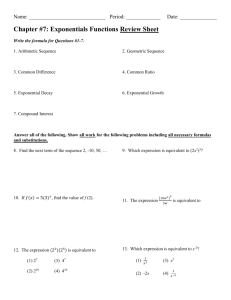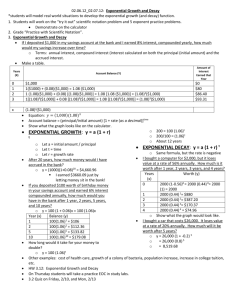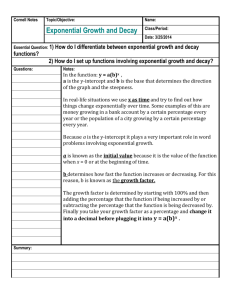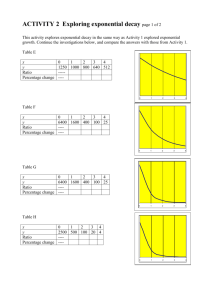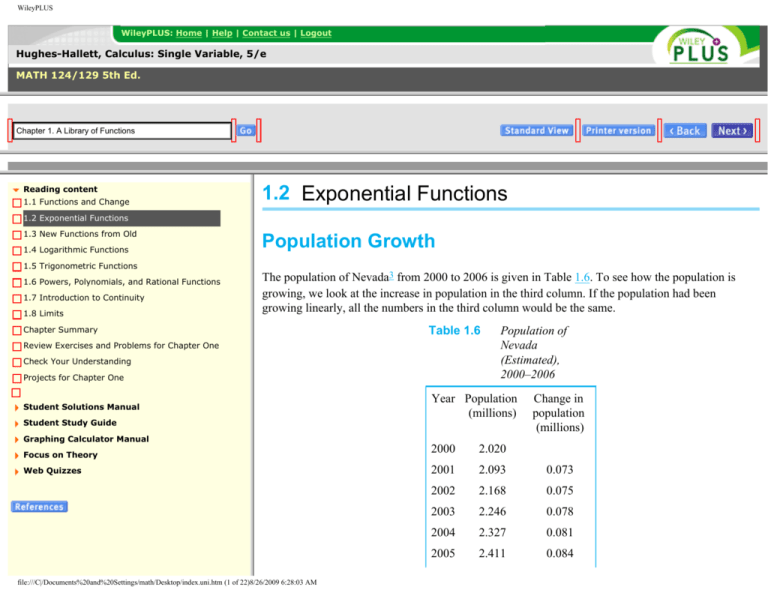
WileyPLUS
WileyPLUS: Home | Help | Contact us | Logout
Hughes-Hallett, Calculus: Single Variable, 5/e
MATH 124/129 5th Ed.
Chapter 1. A Library of Functions
Reading content
1.1 Functions and Change
1.2 Exponential Functions
1.2 Exponential Functions
1.3 New Functions from Old
1.4 Logarithmic Functions
Population Growth
1.5 Trigonometric Functions
1.6 Powers, Polynomials, and Rational Functions
1.7 Introduction to Continuity
1.8 Limits
The population of Nevada3 from 2000 to 2006 is given in Table 1.6. To see how the population is
growing, we look at the increase in population in the third column. If the population had been
growing linearly, all the numbers in the third column would be the same.
Chapter Summary
Table 1.6
Review Exercises and Problems for Chapter One
Check Your Understanding
Projects for Chapter One
Student Solutions Manual
Student Study Guide
Population of
Nevada
(Estimated),
2000–2006
Year Population
(millions)
Graphing Calculator Manual
Focus on Theory
Web Quizzes
file:///C|/Documents%20and%20Settings/math/Desktop/index.uni.htm (1 of 22)8/26/2009 6:28:03 AM
Change in
population
(millions)
2000
2.020
2001
2.093
0.073
2002
2.168
0.075
2003
2.246
0.078
2004
2.327
0.081
2005
2.411
0.084
WileyPLUS
2006
2.498
0.087
Suppose we divide each year's population by the previous year's population. For example,
The fact that both calculations give 1.036 shows the population grew by about 3.6% between 2000
and 2001 and between 2001 and 2002. Similar calculations for other years show that the population
grew by a factor of about 1.036, or 3.6%, every year. Whenever we have a constant growth factor
(here 1.036), we have exponential growth. The population t years after 2000 is given by the
exponential function
If we assume that the formula holds for 50 years, the population graph has the shape shown in Figure
1.16. Since the population is growing faster and faster as time goes on, the graph is bending upward;
we say it is concave up. Even exponential functions which climb slowly at first, such as this one,
eventually climb extremely quickly.
t
To recognize that a table of t and P values comes from an exponential function P = P0a , look
for ratios of P values that are constant for equally spaced t values.
file:///C|/Documents%20and%20Settings/math/Desktop/index.uni.htm (2 of 22)8/26/2009 6:28:03 AM
WileyPLUS
Figure 1.16 Population of Nevada (estimated): Exponential growth
Concavity
We have used the term concave up4 to describe the graph in Figure 1.16. In words:
The graph of a function is concave up if it bends upward as we move left to right; it is concave
down if it bends downward. (See Figure 1.17 for four possible shapes.) A line is neither
concave up nor concave down.
Figure 1.17 Concavity of a graph
Elimination of a Drug from the Body
Now we look at a quantity which is decreasing exponentially instead of increasing. When a patient is
file:///C|/Documents%20and%20Settings/math/Desktop/index.uni.htm (3 of 22)8/26/2009 6:28:03 AM
WileyPLUS
given medication, the drug enters the bloodstream. As the drug passes through the liver and kidneys,
it is metabolized and eliminated at a rate that depends on the particular drug. For the antibiotic
ampicillin, approximately 40% of the drug is eliminated every hour. A typical dose of ampicillin is
250 mg. Suppose Q = f (t), where Q is the quantity of ampicillin, in mg, in the bloodstream at time t
hours since the drug was given. At t = 0, we have Q = 250. Since every hour the amount remaining is
60% of the previous amount, we have
and after t hours,
This is an exponential decay function. Some values of the function are in Table 1.7; its graph is in
Figure 1.18.
Table 1.7
t
Q
(hours) (mg)
file:///C|/Documents%20and%20Settings/math/Desktop/index.uni.htm (4 of 22)8/26/2009 6:28:03 AM
0
250
1
150
2
90
3
54
4
32.4
5
19.4
WileyPLUS
Figure 1.18 Drug elimination: Exponential decay
Notice the way the function in Figure 1.18 is decreasing. Each hour a smaller quantity of the drug is
removed than in the previous hour. This is because as time passes, there is less of the drug in the
body to be removed. Compare this to the exponential growth in Figure 1.16, where each step upward
is larger than the previous one. Notice, however, that both graphs are concave up.
The General Exponential Function
We say P is an exponential function of t with base a if
where P0 is the initial quantity (when t = 0) and a is the factor by which P changes when t
increases by 1.
If a > 1, we have exponential growth; if 0 < a < 1, we have exponential decay.
Provided a > 0, the largest possible domain for the exponential function is all real numbers. The
reason we do not want a ≤ 0 is that, for example, we cannot define a1/2 if a < 0. Also, we do not
t
usually have a = 1, since P = P01 = P0 is then a constant function.
file:///C|/Documents%20and%20Settings/math/Desktop/index.uni.htm (5 of 22)8/26/2009 6:28:03 AM
WileyPLUS
The value of a is closely related to the percent growth (or decay) rate. For example, if a = 1.03, then
P is growing at 3%; if a = 0.94, then P is decaying at 6%.
Example 1
Suppose that Q = f (t) is an exponential function of t. If f (20) = 88.2 and f (23) = 91.4:
(a) Find the base.
(b) Find the growth rate.
(c) Evaluate f (25).
Solution
(a) Let
Substituting t = 20, Q = 88.2 and t = 23, Q = 91.4 gives two equations for Q0
and a:
Dividing the two equations enables us to eliminate Q0:
Solving for the base, a, gives
(b) Since a = 1.012, the growth rate is 0.012 = 1.2%.
file:///C|/Documents%20and%20Settings/math/Desktop/index.uni.htm (6 of 22)8/26/2009 6:28:03 AM
WileyPLUS
(c) We want to evaluate f (25) = Q0a25 = Q0(1.012)25. First we find Q0 from the
equation
Solving gives Q0 = 69.5. Thus,
Half-Life and Doubling Time
Radioactive substances, such as uranium, decay exponentially. A certain percentage of the mass
disintegrates in a given unit of time; the time it takes for half the mass to decay is called the half-life
of the substance.
A well-known radioactive substance is carbon-14, which is used to date organic objects. When a
piece of wood or bone was part of a living organism, it accumulated small amounts of radioactive
carbon-14. Once the organism dies, it no longer picks up carbon-14. Using the half-life of carbon-14
(about 5730 years), we can estimate the age of the object. We use the following definitions:
The half-life of an exponentially decaying quantity is the time required for the quantity to be
reduced by a factor of one half.
The doubling time of an exponentially increasing quantity is the time required for the quantity
to double.
The Family of Exponential Functions
t
The formula P = P0a gives a family of exponential functions with positive parameters P0 (the initial
quantity) and a (the base, or growth/decay factor). The base tells us whether the function is increasing
(a > 1) or decreasing (0 < a < 1). Since a is the factor by which P changes when t is increased by 1,
file:///C|/Documents%20and%20Settings/math/Desktop/index.uni.htm (7 of 22)8/26/2009 6:28:03 AM
WileyPLUS
large values of a mean fast growth; values of a near 0 mean fast decay. (See Figures 1.19 and 1.20.)
t
All members of the family P = P0a are concave up.
Figure 1.19 Exponential growth: P = at, for a > 1
Figure 1.20 Exponential decay: P = at, for 0 < a < 1
file:///C|/Documents%20and%20Settings/math/Desktop/index.uni.htm (8 of 22)8/26/2009 6:28:03 AM
WileyPLUS
Example 2
Figure 1.21 is the graph of three exponential functions. What can you say about the
values of the six constants, a, b, c, d, p, q?
Figure 1.21
Solution
All the constants are positive. Since a, c, p represent y-intercepts, we see that a = c
because these graphs intersect on the y-axis. In addition, a = c < p, since y = p · q
crosses the y-axis above the other two.
x
x
Since y = a · b is decreasing, we have 0 < b < 1. The other functions are increasing, so
1 < d and 1 < q.
Exponential Functions with Base e
The most frequently used base for an exponential function is the famous number e = 2.71828…. This
x
base is used so often that you will find an e button on most scientific calculators. At first glance, this
is all somewhat mysterious. Why is it convenient to use the base 2.71828…? The full answer to that
question must wait until Chapter 3, where we show that many calculus formulas come out neatly
when e is used as the base. We often use the following result:
file:///C|/Documents%20and%20Settings/math/Desktop/index.uni.htm (9 of 22)8/26/2009 6:28:03 AM
WileyPLUS
Any exponential growth function can be written, for some a > 1 and k > 0, in the form
and any exponential decay function can be written, for some 0 < a < 1 and k > 0, as
where P0 and Q0 are the initial quantities.
We say that P and Q are growing or decaying at a continuous5 rate of k. (For example, k = 0.02
corresponds to a continuous rate of 2%.)
Example 3
t
t
t
Convert the functions P = e0.5 and Q = 5e-0.2 into the form y = y0a . Use the results to
explain the shape of the graphs in Figures 1.22 and 1.23.
Figure 1.22 An exponential growth function
file:///C|/Documents%20and%20Settings/math/Desktop/index.uni.htm (10 of 22)8/26/2009 6:28:03 AM
WileyPLUS
Figure 1.23 An exponential decay function
Solution
We have
Thus, P is an exponential growth function with P0 = 1 and a = 1.65. The function is
increasing and its graph is concave up, similar to those in Figure 1.19. Also,
so Q is an exponential decay function with Q0 = 5 and a = 0.819. The function is
decreasing and its graph is concave up, similar to those in Figure 1.20.
file:///C|/Documents%20and%20Settings/math/Desktop/index.uni.htm (11 of 22)8/26/2009 6:28:03 AM
WileyPLUS
Example 4
The quantity, Q, of a drug in a patient's body at time t is represented for positive
kt
constants S and k by the function Q = S(1 - e- ). For t ≥ 0, describe how Q changes
with time. What does S represent?
Solution
The graph of Q is shown in Figure 1.24. Initially none of the drug is present, but the
quantity increases with time. Since the graph is concave down, the quantity increases at
a decreasing rate. This is realistic because as the quantity of the drug in the body
increases, so does the rate at which the body excretes the drug. Thus, we expect the
quantity to level off. Figure 1.24 shows that S is the saturation level. The line Q = S is
called a horizontal asymptote.
Figure 1.24 Buildup of the quantity of a drug in body
Exercises and Problems for Section 1.2
file:///C|/Documents%20and%20Settings/math/Desktop/index.uni.htm (12 of 22)8/26/2009 6:28:03 AM
WileyPLUS
Exercises
In Exercises 1, 2, 3 and 4, decide whether the graph is concave up, concave down, or neither.
1.
2.
3.
4.
The functions in Exercises 5, 6, 7 and 8 represent exponential growth or decay. What is the initial
quantity? What is the growth rate? State if the growth rate is continuous.
5. P = 5(1.07)t
6. P = 7.7(0.92)t
file:///C|/Documents%20and%20Settings/math/Desktop/index.uni.htm (13 of 22)8/26/2009 6:28:03 AM
WileyPLUS
7. P = 3.2e0.03t
8. P = 15e-0.06t
t
Write the functions in Problems 9, 10, 11 and 12 in the form P = P0a . Which represent exponential
growth and which represent exponential decay?
9. P = 15e0.25t
10. P = 2e-0.5t
11. P = P e0.2t
0
12. P = 7e-πt
t
t
In Problems 13 and 14, let f (t) = Q0a = Q0(1 + r) .
(a) Find the base, a.
(b) Find the percentage growth rate, r.
13. f (5) = 75.94 and f (7) = 170.86
14. f (0.02) = 25.02 and f (0.05) = 25.06
15. A town has a population of 1000 people at time t = 0. In each of the following cases, write a
formula for the population, P, of the town as a function of year t.
(a) The population increases by 50 people a year.
(b) The population increases by 5% a year.
file:///C|/Documents%20and%20Settings/math/Desktop/index.uni.htm (14 of 22)8/26/2009 6:28:03 AM
WileyPLUS
16. Identify the x-intervals on which the function graphed in Figure 1.25 is:
(a) Increasing and concave up
(b) Increasing and concave down
(c) Decreasing and concave up
(d) Decreasing and concave down
Figure 1.25
Problems
17. An air-freshener starts with 30 grams and evaporates. In each of the following cases, write a
formula for the quantity, Q grams, of air-freshener remaining t days after the start and sketch a
graph of the function. The decrease is:
(a) 2 grams a day
(b) 12% a day
file:///C|/Documents%20and%20Settings/math/Desktop/index.uni.htm (15 of 22)8/26/2009 6:28:03 AM
WileyPLUS
18. In 2007, the world's population reached 6.7 billion and was increasing at a rate of 1.2% per year.
Assume that this growth rate remains constant. (In fact, the growth rate has decreased since
1987.)
(a) Write a formula for the world population (in billions) as a function of the number of years
since 2007.
(b) Use your formula to estimate the population of the world in the year 2020.
(c) Sketch a graph of world population as a function of years since 2007. Use the graph to
estimate the doubling time of the population of the world.
19. A photocopy machine can reduce copies to 80% of their original size. By copying an already
reduced copy, further reductions can be made.
(a) If a page is reduced to 80%, what percent enlargement is needed to return it to its original
size?
(b) Estimate the number of times in succession that a page must be copied to make the final
copy less than 15% of the size of the original.
20. When a new product is advertised, more and more people try it. However, the rate at which new
people try it slows as time goes on.
(a) Graph the total number of people who have tried such a product against time.
(b) What do you know about the concavity of the graph?
21. Sketch reasonable graphs for the following. Pay particular attention to the concavity of the
graphs.
(a) The total revenue generated by a car rental business, plotted against the amount spent on
advertising.
(b) The temperature of a cup of hot coffee standing in a room, plotted as a function of time.
Give a possible formula for the functions in Problems 22, 23, 24 and 25.
file:///C|/Documents%20and%20Settings/math/Desktop/index.uni.htm (16 of 22)8/26/2009 6:28:03 AM
WileyPLUS
22.
23.
24.
25.
26.
(a) A population, P, grows at a continuous rate of 2% a year and starts at 1 million. Write P
kt
in the form P = P0e , with P0, k constants.
(b) Plot the population in part (a) against time.
27. When the Olympic Games were held outside Mexico City in 1968, there was much discussion
about the effect the high altitude (7340 feet) would have on the athletes. Assuming air pressure
decays exponentially by 0.4% every 100 feet, by what percentage is air pressure reduced by
moving from sea level to Mexico City?
file:///C|/Documents%20and%20Settings/math/Desktop/index.uni.htm (17 of 22)8/26/2009 6:28:03 AM
WileyPLUS
28. During April 2006, Zimbabwe's inflation rate averaged 0.67% a day. This means that, on
average, prices went up by 0.67% from one day to the next.
(a) By what percentage did prices in Zimbabwe increase in April of 2006?
(b) Assuming the same rate all year, what was Zimbabwe's annual inflation rate during 2006?
29.
(a) The half-life of radium-226 is 1620 years. Write a formula for the quantity, Q, of radium
left after t years, if the initial quantity is Q0.
(b) What percentage of the original amount of radium is left after 500 years?
30. In the early 1960s, radioactive strontium-90 was released during atmospheric testing of nuclear
weapons and got into the bones of people alive at the time. If the half-life of strontium-90 is 29
years, what fraction of the strontium-90 absorbed in 1960 remained in people's bones in 1990?
31. A certain region has a population of 10,000,000 and an annual growth rate of 2%. Estimate the
doubling time by guessing and checking.
32. Aircraft require longer takeoff distances, called takeoff rolls, at high altitude airports because of
diminished air density. The table shows how the takeoff roll for a certain light airplane depends
on the airport elevation. (Takeoff rolls are also strongly influenced by air temperature; the data
shown assume a temperature of 0°C.) Determine a formula for this particular aircraft that gives
the takeoff roll as an exponential function of airport elevation.
file:///C|/Documents%20and%20Settings/math/Desktop/index.uni.htm (18 of 22)8/26/2009 6:28:03 AM
Elevation Sea
(ft)
level
1000
2000
3000
4000
Takeoff
roll (ft)
734
805
882
967
670
WileyPLUS
33. Each of the functions g, h, k in Table 1.8 is increasing, but each increases in a different way.
Which of the graphs in Figure 1.26 best fits each function?
Table 1.8
t g(t) h(t) k(t)
1 23
10
2.2
2 24
20
2.5
3 26
29
2.8
4 29
37
3.1
5 33
44
3.4
6 38
50
3.7
Figure 1.26
34. Each of the functions in Table 1.9 decreases, but each decreases in a different way. Which of the
graphs in Figure 1.27 best fits each function?
Table 1.9
file:///C|/Documents%20and%20Settings/math/Desktop/index.uni.htm (19 of 22)8/26/2009 6:28:03 AM
WileyPLUS
x f (x)
g(x)
h(x)
1 100
22.0
9.3
2
90
21.4
9.1
3
81
20.8
8.8
4
73
20.2
8.4
5
66
19.6
7.9
6
60
19.0
7.3
Figure 1.27
35.
(a) Which (if any) of the functions in the following table could be linear? Find formulas for
those functions.
(b) Which (if any) of these functions could be exponential? Find formulas for those functions.
x f (x) g(x) h(x)
file:///C|/Documents%20and%20Settings/math/Desktop/index.uni.htm (20 of 22)8/26/2009 6:28:03 AM
- 12
2
16
37
- 17
1
24
34
0 20
36
31
1 21
54
28
2 18
81
25
WileyPLUS
36. The median price, P, of a home rose from $60,000 in 1980 to $180,000 in 2000. Let t be the
number of years since 1980.
(a) Assume the increase in housing prices has been linear. Give an equation for the line
representing price, P, in terms of t. Use this equation to complete column (a) of Table
1.10. Use units of $1000.
(b) If instead the housing prices have been rising exponentially, find an equation of the form
t
P = P0a to represent housing prices. Complete column (b) of Table 1.10.
(c) On the same set of axes, sketch the functions represented in column (a) and column (b) of
Table 1.10.
(d) Which model for the price growth do you think is more realistic?
Table 1.10
t
(a)
Linear
growth
price in
$1000
units
(b)
Exponential
growth price
in $1000
units
0
60
60
180
180
10
20
30
40
file:///C|/Documents%20and%20Settings/math/Desktop/index.uni.htm (21 of 22)8/26/2009 6:28:03 AM
WileyPLUS
37. Estimate graphically the doubling time of the exponentially growing population shown in Figure
1.28. Check that the doubling time is independent of where you start on the graph. Show
t
algebraically that if P = P0a doubles between time t and time t + d, then d is the same number
for any t.
Figure 1.28
Copyright © 2009 John Wiley & Sons, Inc. All rights reserved.
file:///C|/Documents%20and%20Settings/math/Desktop/index.uni.htm (22 of 22)8/26/2009 6:28:03 AM




